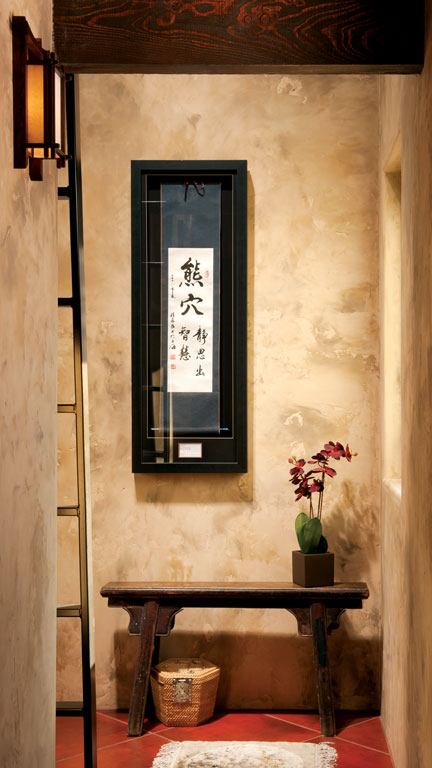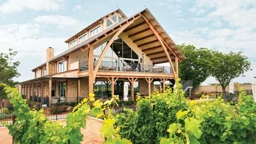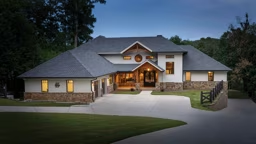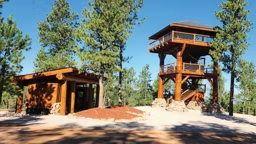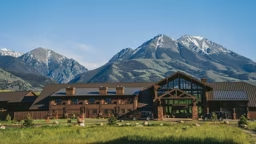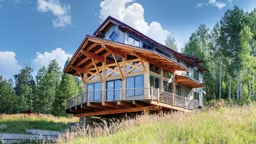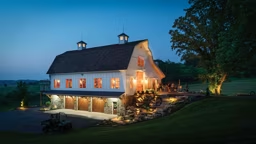When one thinks of Bigfork, Montana, soaring mountain ranges, majestic vistas and grand homes come to mind. The town even boasts Flathead Lake, the largest natural freshwater lake west of the Mississippi. In short, “small” is not often used to describe the elements found in Big Sky Country. But in the case of a family compound expansion designed and built by Ron Incoronato of Ron Incoronato & Co., the adjective that comes to mind is just that — small.
When the homeowners purchased two lots across the street from their main house to build guesthouses for their children and grandchildren, they decided to depart from the traditional vernacular design of the area. The two cottages, “Bear’s Den” and “Bird’s Nest,” as well as “Hog House” — a garage to store the homeowner’s collection of Harley Davidsons — are all a modest 600 square feet. But while the size of the buildings is reduced, the design is an impressive fusion of Asian architecture with a rugged, Western flair.
See also Anatomy of a Small (and Smart) Timber Frame Home
Asian Fusion
Before starting on the guesthouse project, Ron had been a friend of the homeowner for years. In fact, they were classmates. “We went to high school together then to the University of Montana and then, ironically, we both spent time living in Asia — Indonesia, Taipei, Thailand — among other places,” notes Ron. “We both really fell in love with Asian architecture and furnishings.” Because of this love, the homeowners amassed a collection of Asian architectural salvage and antiques over the years, and wanted to incorporate as many of these pieces into the new guesthouses and garage as possible. To achieve this, the lifelong friends decided to combine a variety of Asian design motifs into the architecture rather than put any particular stylistic label on the structures.
The result: stunning Asian-inspired exteriors with tapered stone wainscoting and stucco surfaces. Massive structural timbers form the entryways and wide roof fascia. Support beams are left exposed on the walls of the houses. While these are not reclaimed timbers, Ron blasted them with cornhusks to give them a weathered, Old World look. “We then finished the beams with a dark stain to further the patina,” he notes. One of the more important and impressive elements of the timber frame cottages are the roofs. The curved shape and deep eaves not only protect from rain and sun, but also it is believed in the Buddhist religion that the slight flared slope would deter evil spirits from entering the house.
The roof tiles are not traditional clay, as you would find in Asia, but rather a formed metal tile that gives the appearance of clay. “It was also thought in Japanese mythology that the roof tiles were formed in such a way to resemble water ripples so the fire gods would not strike the house with lightening,” notes Ron.
Added Efficiency
Ron also went to great lengths to make the timber frame cottages as efficient as possible. The roofs don’t have gutters but rather drainpipes buried under the ground, so the water runs into the manmade canal. Although the houses are small, they are sturdy and well insulated, with 2-by-6-inch wall construction and 2-inch foam insulation. “Although the houses are compact, the homeowners wanted them to function as typical homes would,” notes Ron.
For instance, each house has a functional kitchen, washer and dryer, heated flooring, a gas-burning stove, dining and living area, two bedrooms, and a full bathroom, complete with steam shower. To fit all of these requirements into the small space, Ron designed an open layout with a second floor loft tucked under the eaves. Under the loft in the “Bear’s Den” is one of the most magnificent pieces that the couple acquired while overseas — a centuries old concubine bed. The freestanding bedchamber is decorated with elaborate carvings and has a foyer. “I pieced the chamber together with its original mortise-and-tenon joinery,” Ron explains. “There are no screws or bolts or nails — just the original joinery.” The “Bear’s Den” also boasts a space-saving built-in eating nook in the dining area, allowing for more floor space in the room.
All the appliances are miniature in size as well. Ron also built the cabinetry, which is painted black to offer the look of lacquered Chinese pieces. Wall niches above the gas-burning stove (which heats the whole house) in the living area are another space-saver and display the couple’s Asian artifacts. As a trio, the guest buildings bring joy in many ways to the couple — they are reminded of their time living in Asia while having ample space for their grandkids to come and stay.
Home Details
Square footage: 600 each
Builder: Ron Incoronato & Co.
See also: A Small Timber Home Lives Large











